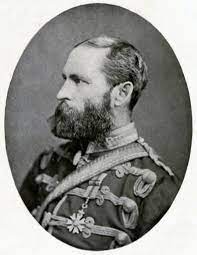MACLEOD, James Farquharson (1836-1894)
Colonel James Farquharson Macleod
Commissioner of N.W.M.P. and he named Calgary

Col. James Macleod
Born: 25 Sept 1836 at Drynoch, Isle of Skye, Scotland
Married: 28 July 1876 to Mary Isabella Drever
Died: 5 Sept 1894 (age 58) at Calgary, Alberta
Buried: Union Cemetery, Calgary, Alberta, plot B:01:016
Contributor: Jim Benedict
James’ Parents
- Father: Martin Donald Macleod
- Mother: Jane Fry
His Early Years
Born on the Isle of Skye, Scotland, James migrated with his family to Canada in 1854 where his father purchased a farm at Richmond Hill, north of Toronto. Those early years on the farm infused in James an appreciation for the land and the outdoors. Hunting trips with his father and brothers left him with an abiding love of the outdoor life. The Macleod family also had a friendship with a family of local Ojibwa people which imparted to James a lifelong respect and admiration for the native people of Canada.1
James Macleod’s father, who had lost seven brothers to tropical diseases while they were serving in the British and Indian armies and who had himself fallen seriously ill while on military service in Demerara (Guyana), had left Scotland to avoid a similar fate for his sons.
James had been educated at home, but his father enrolled him at Upper Canada College, he then went on to Queen’s College in Kingston and at Osgood Hall, both in Ontario. He then began a career in law in 1860 in Bowmanville, Ontario. But he also had a passion for military and in the summer of 1856, he joined the Volunteer Militia Field Battery in Kingston, as a lieutenant, under Colonel Wolseley. In 1862 he was transferred to the Bowmanville Volunteer Militia Rifle Company where he was promoted captain in 1863 and major in 1866.
In 1879, with political influence of his former employer, Alexander Campbell, Macleod obtained a commission as brigade-major with the expedition under Col. Wolseley, sent to quell the uprising in the Red River settlement in Manitoba. Macleod stayed at Lower Fort Garry until the spring of 1871, where he met Mary Isabella Drever. Mary was born in the Red River settlement and was the daughter of a local trader. Their marriage plans were postponed when Macleod failed to obtain appointment as a commanding officer of the garrison and had to return to Ontario, where he was promoted to lieutenant-colonel in the 45th Battalion of Infantry in December of 1871. By this time, his interest in a career in law and also in part-time soldiering was waning, and he decided to head to England and Scotland for potential employment.
Two years later, in the spring of 1873, Prime Minister Macdonald offered Macleod a commission as superintendent and inspector in the newly-formed North West Mounted Police. James Macleod accepted at age 47 and promptly returned to Canada. by October, he headed west for Upper Fort Garry (now Winnipeg) with several other officers and 150 men. The troop traveled by railway, then river boat through the United States, to join up with other members of the force at Fort Dufferin (near Emerson, Manitoba). From there, the mounted force started the Western Trek to bring order to the west.
The North West Mounted Police
If it were not for James F. Macleod, our fair city would have been known as Bow Fort, or even stranger, Fort Brisebois. The NWMP troop headed west from Ontario, facing many arduous hazards, crossing into the prairie territories and setting up Fort Macleod in 1874. Inspired by this handy use of names, F-troop headed up north to start another fort, at the confluence of the Bow and Elbow rivers, and the leader of the troop, one Inspector Ephrem Brisebois, named the fort after himself. For a short stint. Until his boss, Col. James Macleod got wind, who dug into his Scottish heritage and decided on Fort Calgary, named after Calgary Castle on the Isle of Mull.
Macleod was instrumental in making good relations with the local tribes and tried to help with the transition from the nomadic lives when buffalo roamed the prairies. He assisted with the negotiations for Treaty Seven. Later on, James served as a judge of the Supreme Court of the territories.
Mary Isabella Macleod
During his stint in the Red River Rebellion, he met and fell in love with Mary Isabella Drever (1852-1933), a remarkable woman in her own right. Mary was born in the settlement of Red River in 1852. When she was just 17, Mary evaded Metis guards to deliver an important military dispatch to British forces during the Red River Rebellion in 1869. She met her future husband, Colonel James Macleod, and after their marriage on July 28, 1876, they settled at Fort Macleod, south of Calgary.
Mary would often travel with James during his tours of duty as a commissioner of the North-West Mounted Police and she was one of six white women to sign Treaty 7 with the Blackfoot Nation.
James had many responsibilities as a Commissioner, Magistrate, Judge and Legislative councillor and had to spend lots of time away from his wife and five children. He and his wife found other ways to communicate; they regularly exchanged love letters that included passionate expressions of love. “I know that you are very good and the most patient most long-suffering girl in the world…”, Signed, “With endless love, ever yours, Jim”
His Final Years
James Macleod was a major influence on the founding and early development of the town, then city of Calgary. It is fitting that he rest at the highest point of Union Cemetery, overlooking the city that he named and the major thoroughfare which bears his name.
